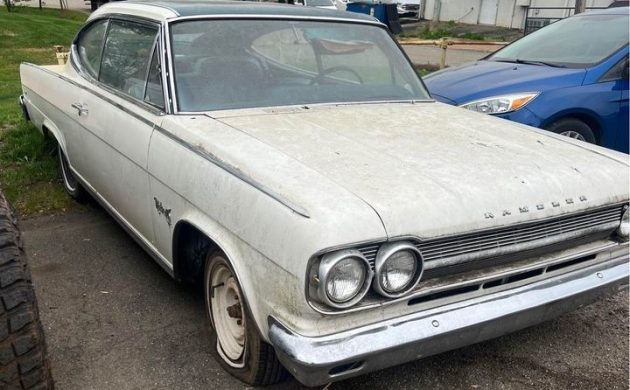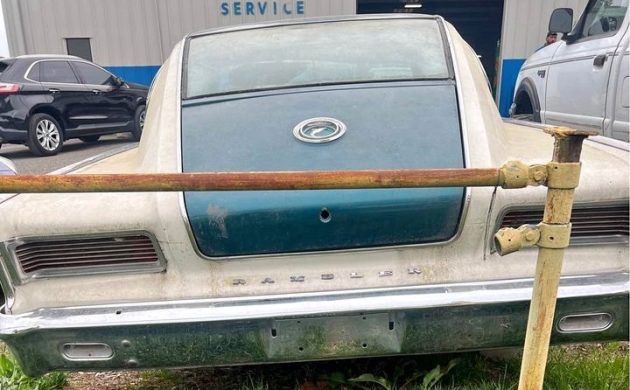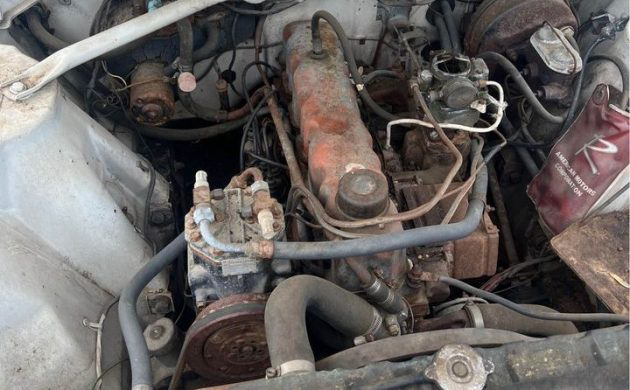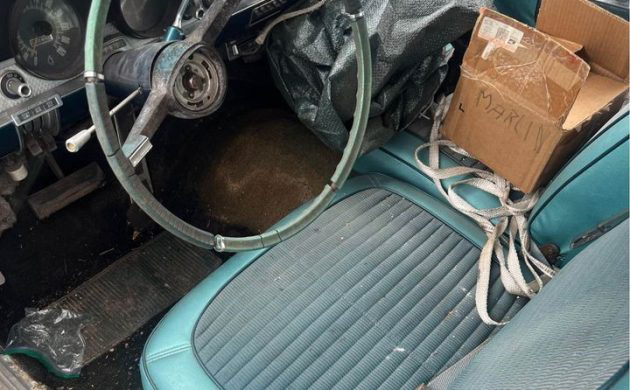
American Motors’ Marlin debuted in 1965 as a fastback version of the Rambler Classic. Looking a bit like an overgrown Plymouth Barracuda, it was a mid-size car for two years and then a full-size in its third and final outing. This ‘65 edition looks reasonably solid and runs but doesn’t necessarily stop. Located in a shop yard in Rutherfordton, North Carolina, this somewhat rare find is available here on Facebook Marketplace for $8,500. Our gratitude goes to T.J. for yet another great tip!

The roots of the Marlin lie in the 1964 Rambler Tarpon, which was a show car. That’s where the distinctive fastback roofline came from. Perhaps the 1964 ½ Ford Mustang served as an inspiration to the Marlin but work on the Rambler was likely underway by the time the Mustang was unveiled. The automobile served as something of a personal luxury car and the layout of the auto would be emulated to an extent by the 1966 Dodge Charger. So, everyone was getting in on the act. For ’65, the car was called the Rambler Marlin, then just Marlin for 1966, and the AMC Marlin in 1967 (as the company was already starting to downplay the Rambler moniker).

Marlin production numbers weren’t huge (by Detroit standards) with 10,300 copies in ’65 with less than half that in ’66. The bigger ’67 version saw even fewer assemblies at some 2,500. Most buyers opted for a V8, so the 232 cubic inch inline-6 in the seller’s car is one of only about 2,000 made. This edition has its fair share of goodies, with an automatic transmission and factory air conditioning. No history is offered on the car other than it seems to be mostly original.

The body on this AMC seems to have escaped the wrath of Mother Nature if it had been stored outside. The white and blue paint may be okay and good detailing would tell us if there is reason to worry. We’re told the engine works but the brakes do not. The interior may be okay, too, but the photos don’t provide us with a wide range of views. If you’re an AMC fan, the Marlin is one of their more interesting products, coming years before the AMX, Gremlin, and other adaptations of existing products.


I’m not sure who gets the credit for these fastbacks. All seem to generate from the mid 60s. They probably all were in a big room, making fastbacks out of relatively basic cars, Falcon/Mustang, Barracuda( that was almost named “Panda”)/Valiant, Marlin/Classic, Marlin the least successful. Tom us in Wisconsin, the Marlin was an embarrassment, but was actually a pretty neat car. Again, the Rambler roots was its downfall. As I got older, I appreciated what the Marlin was, but too late.
At a recent car show, 2 sisters had a Marlin that their late mom bought new. Luckily, they kept the car. Naturally, I was flabbergasted, and asked if I could see the motor. The gals looked at each other with puzzled looks,,,they didn’t know where the hood release was. I was the hero, “it’s right here”(pointing at the grill). This, to me, is a great find, how one ended up in NC is anyone’s guess, I think this car has a good chance of being saved, not because it came from the greatest car maker( cough), but just because it’s so unusual, and I guess we’ll take it as a compliment.
Something is going on with the brakes on this Marlin. For 1965 the car would have come with standard power front disc brakes but under the hood it looks like a drum brake master cylinder has been substituted. (Maybe at some point front drum brakes were fitted?) Also the original disc brake system came with an odd “non-servo” rear drum setup for which parts are unobtainium. Could be the brakes don’t work because they’ve been badly hacked up in an attempt to excise the ancient disc brake setup.
Looks like the hood ornament is missing, as is the trunk lock cylinder, and the interior is a hot mess. If it’s as solid underneath as the body appears to be that’s the main saving grace of this one.
I would be willing to bet that master cylinder situation happened quite a bit more than people realize, due to rebuilt units sold by the big chain stores. More than once, I removed a drum brake m/c from a box when I had requested a disc brake unit.
The drum brake master will work with discs but you have to keep an eye on fluid level on the disc brake side since it will drop as the pads wear. I think there’s also a residual pressure valve used with drum brakes that should be removed, otherwise the disc brake pads will drag.
I believe that parts for the old 4-piston Bendix disc brake setup are still available, albeit expensive. Parts for the non-servo rear drums are not. The thing to do would be to install standard-type Bendix rear drum brakes and a proportioning valve. (This is a bigger job than might be expected due to AMC’s unique two-piece hub and axle shaft design.)
I’m not sure about the disc brake thing, I’m not that familiar with AMC, but dual master cylinders weren’t used till 67, so apparently there’s been some sort of alterations
Tried to look at other 65 Marlins. It seems that the few i could observe have a master cylinder that is drum/drum. This could be because of incorrect repairs or perhaps there was a “delete” option which saved a few bucks. Or AMC used a drum/drum style M/C (save a few $) with the residual check valve removed.
Poor AMC. They heard rumblings of the Mustang, and Barracuda, and came up with…this.
Dick Teague, who was new in his job at the time, had done a fastback version of the smaller American. It hit the car shows and everyone loved it; but Roy Abernathy personally intervened. Ramblers, he pontificated, were for practical people. Grownups need headroom in the back seat.
So the roofline was modified, making it look awkward, and the greenhouse mated to the Classic chassis and lower portion. What came out of that, was something that would have made Homer Simpson proud.
Agreed JustPassinThru. AMC was run by stodgy old men who had almost no clue about styling. That’s the real reason AMC was bought by Chrysler instead of the other way around. Many of AMC’s cars were gargoyles on wheels. Remember the Coffin cars of the late 70s? Only in the muscle car era were AMCs properly proportioned. By 1967 the Marlin had been restyled and the goofy roofline refined. But too late to save the marque.
In the early 60s, Chrysler’s offerings looked like one squashed car pancaked on top of another. Their sales nosedived until they fixed their world class automotive monstrosities and that propelled them into the K car era. Even then they remembered the early 60s styling lesson.
Ford has always relied on styling to overcome their Fix Or Repair Daily image. When they ran into catastrophic rust problems in the 70s their styling kept them selling well. GM had a humongous paint adhesion problem in the 90s that would have sunk them if their styling didn’t save them too.
All car makers produce stinkers from time to time, but AMC from a styling perspective, produced well-engineered styling boners as their bread and butter. Most people want a car they are proud to be seen in and that they can be proud of. They want their cars to look like they knew what they were doing when they made their purchasing decision.
The reason AMC was blind to this is because it was a company run by engineers and bean counters. Their designers were consistently overruled by people with practically no comprehension of the importance of styling.
That reality is based on engineers and bean counters having little to no sense of proportion. Engineering types make things work. To them, looks take a back seat to functionality.
When you compare AMC functionality to GM, Ford or Chrysler, you find that AMC cars are engineered to be extremely simple and easy to work on. They are a mechanics dream. Plenty of mechanics drove AMCs for this reason.
AMC used everyone elses parts. You say Ford’s were Fix Or Repair Daily? The acronym for AMC was All Makes of Cars.
Fix “Or” Repair? Isn’t that a bit redundant? And it was a crock anyway
This is one solid looking Marlin, but for that kind of money, they could at least have got some tires on it, threw the garbage out of the interior, and cleaned up the paint on the body- I’ll bet with some polish this car would still shine
People who don’t know about AMCs think they are junk and generally undervalue them. So freqently they can be had for a song from someone who isn’t clued in. This is someone who may be clued in but still doesn’t car for AMCs. Still the price isn’t bad given that Marlins have desirable cars recently.
I make new rear quarters for Marlins and in the last year, their popularity has passed the Rebel Machine, Rebel SST and Matador.
Younger buyers are not saddled with the hostile beliefs that previous generations were and are finding that AMCs are as good or better than their competition in terms of passenger car value.
Another thing to understand is that Marlins were never full size cars. The 1967 Marlins were built on the Rebel/Ambassador/Matador platform. The Rebel was an intermediate car and the Ambassador/Matadors shared the same intermediate wheel base. The difference was that 2″ were added to the frame rail length for the Ambassador and later for the Matator.
The front fenders of the intermediate 1967 Rebels were the exact same fenders used on the Marlin. The lengths of Rebels and Marlins were identical.
The bones of AMCs were mostly good – after they got past the 1956-62 Ramblers, which looked strange, rusted fast, and were assembled too quickly, trying to meet a sudden temporary sales surge.
I owned a Gremlin, as well as a couple of AM-General-era Postal jeeps. The six-cylinder engine, later to be known as the Jeep Six…was designed to be everything the aluminum 1960-63 failure-of-a-six was not. It was a clean-slate, with seven main bearings – rare at the time – and over 600 pounds, speaking of how they wanted it tough as an anvil.
All those AMC products I had had sixes. Never any trouble with them – one of them smoked from worn valve guides, but it always started and ran. Hotter plugs took care of oil fouling.
The transmissions were another matter. Warner Gear was the preferred vendor – both the three-speed manual and the automatic (Post Office personnel called it the Mickey Mouse) were trouble. By the time I owned those, Warner Gear transmissions were pretty much gone, in favor of Saginaw three-speeds and TorqueFlite autos.
The AMC 20 rear axle was weak for Jeeps, which sadly, was where it was used more than anyplace else. It was okay for on-street car use.
Styling: Once Dick Teague got his bearings, the models became attractive if bland. The 1963 Classic fresh-page re-do got Car of the Year nomination. The 1970 Hornet was a winner – and the first years (before the hatchback) avoided the overdone, ubiquitous Coke-Bottle rear-hips.
And I’m in a minority in that I liked the Gremlin. They needed a smaller engine for it; and that was twelve years late when it did come…had they made their four out of the six in 1971 instead of 1983, it could have been inserted in the Gremlin as it was in the Wrangler. All behind the front axle line, giving the Gremlin superior handling. As was done with the YJ – which transformed the chassis, making it a great road vehicle (on leaf springs!).
AMC got no respect, in those years, because they were small; they were without deep pockets and thus couldn’t buy/bribe the buff books, with advertisement budgets. For over ten years, from the mid-1970s, observers expected it to do a Studebaker.
And the slavish masses just parroted the (purchased) opinions given out of Motor Trend and other publicity fronts.
The interchangeable fenders, was part of a campaign started in the mid-1960s to cut costs and share as much as possible across all car lines. It worked, in that it kept the lights on for over 20 years, with a miniscule budget.
A neighbor had a 65 with a 327 4bbl. Kicked ass and was the 1st car I ever drove with front disc brakes. Nearly went through the windshield the 1st time I went to stop.
If you can’t relate to the first time you drove a car with power brakes, you ain’t a genuine “Barn Finds” guy … we all had that “I’m going through the windshield” thought and knowing guys on the street laughed at us …
These always seemed to me that that the stylists came up with such a cool back half and just stuck it on a stodgy front half that they already had, like they just gave up. Just my impression.
That’s why the later Marlins with the stacked headlights were far better looking.
I miss AMC.
The master cylinder can identify as Disc or Drum it’s totally up to it.
As a Stylist, Dick Teague did pretty good for a guy with a glass eye.
You can’t really blame the design team as their hands were tied by
bureaucrats, bean counters and Mr. Abernathy’s meddling with regards to the Marlin..
Personally, I felt AMC designs to be quirky yet a fresh change
from what other manufactures were offering at a higher price point.
I have a 1965 Classic that I put the disc brakes from a 78 Concord on. It was a bolt on other than the hoses and making up new hard lines. Used a late 80s Cherokee booster and master, as well as the proportioning block.